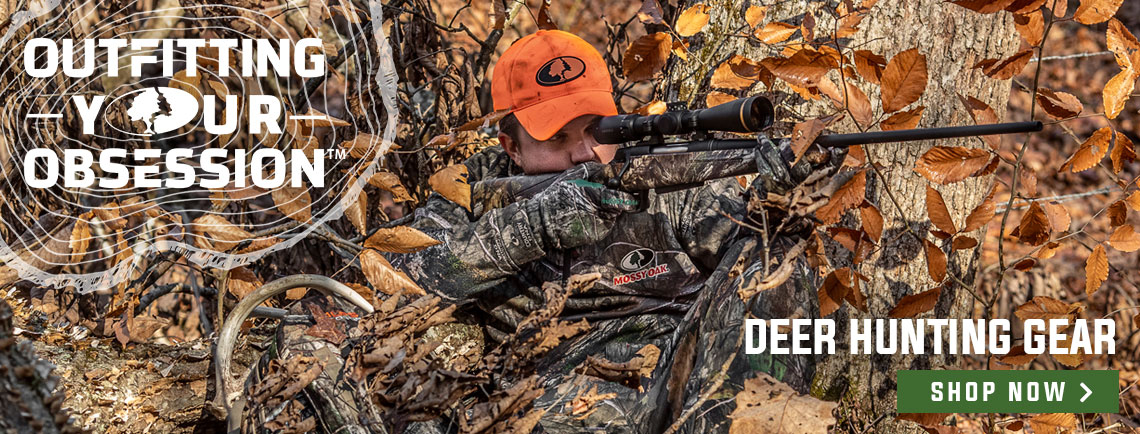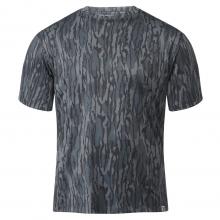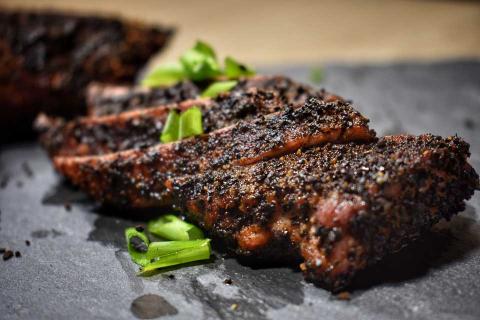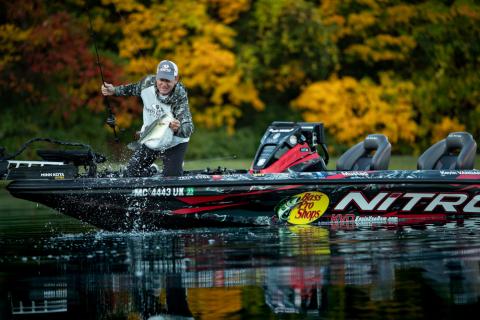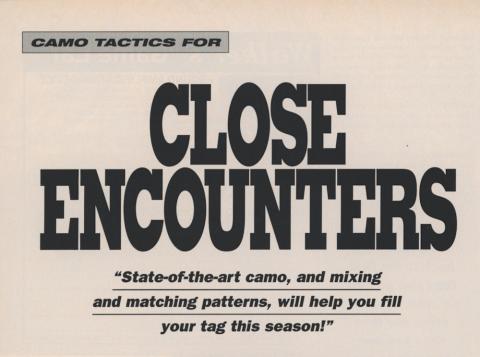William W (Bill) Gabbard
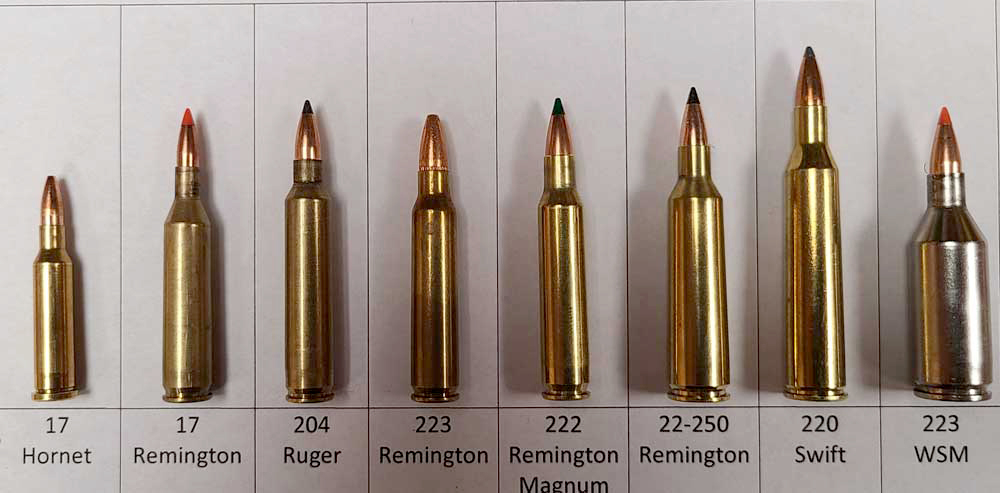
Most of us love shooting varmint rifles. As a rule of thumb, they are accurate, easy to load for, easy on your billfold, both with factory ammo as well as reloading components. Here are seven that I love and one that I hate! I am only going to write about the ones that I have personally worked with so there are good ones that are not covered here.
1. 17 Hornet:
The diminutive 17 Hornet is based on the old favorite 22 Hornet. The 17 has the same cartridge overall length and powder capacity as its parent cartridge but is necked down to .17 caliber. According to Hornady’s 10th Edition Reloading Manual, velocities go up to 3750 fps with a 20-gr bullet. Hodgdon lists velocities up to 3650. These loads produce recoil about like a 22 WMR and trajectories nearly matching a 223 Remington.
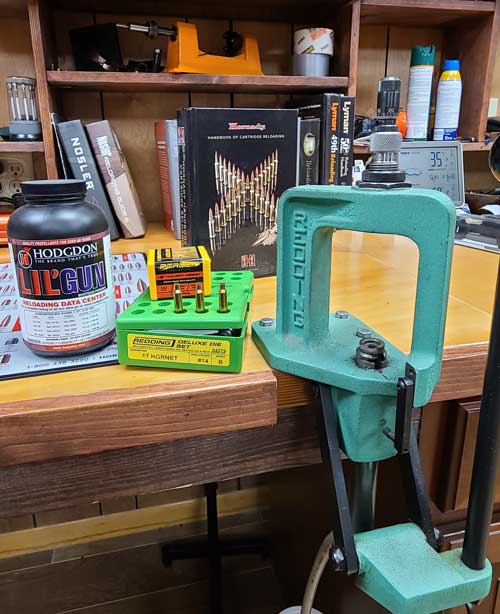
The little Hornet is extremely accurate and produces plenty of energy to dispatch varmints out to around 200 yards. My friend Rick Roberts offered to buy a set of dies and furnish the components if I would help him work up a load for a 17 Hornet for his grandson to hunt with. After very little load development, we settled on a load of 8.8 gr of Hodgdon Lil-Gun and a Berger 25 gr Flat Base Varmint Bullet. This load shot consistently under 0.5 inch at 100 yards with a best group of 0.397 with practically no recoil - perfect for a young hunter to get his feet wet with a centerfire rifle. With this powder charge you should be able to load from 750 to 800 rounds with a pound of powder. Rick’s CZ really liked the Berger Bullet. We had groups under 1 inch at 100 yards using 6 different powders. A note of caution when working with rounds this small - the range of powder charges is often less than 1 grain so a change as little as 0.1 gr can make a difference. BE CAREFUL!
2. 17 Remington:
The 17 Remington is the only other .17 Centerfire that I have worked with. The 17 Remington, which has been around since 1971, is based on the old 222 Remington necked down to .17 caliber. This was the first centerfire 17 caliber that both rifles and ammunition that were commercially available. Cody Little, one of our local Sportsman Club shooters, showed up at my loading bench with a beautiful little CZ 527 rifle chambered in 17 Remington and carrying a set of dies and a box of Hornady 20 gr V-Max bullets and a few Nosler 20 gr Varmageddons. He asked if I had ever loaded for a 17 Remington. I said nope, but I always wanted too! A few sets of trial loads later, we had 4 loads under an inch. Nosler’s Varmageddon and Hodgdon’s Varget had a best of 0.814. Hornady’s V-Max and VihtaVuori N 140 produced 0.808 groups while VihtaVuori N 133 turned in 0.577. Ramshot’s Tac (now under the Hodgdon banner) pushing the Hornady 20 gr V-Max produced an impressive 0.393 group. A pretty darn good setup for a lightweight rifle for crows, groundhogs and the occasional coyote.
3. 204 Ruger:
Talk about a home run! The 204 Ruger, a joint development by Hornady and Ruger, was a grand slam in the varmint-hunting world. I must admit that I was not one of the first to jump on the 204 bandwagon. I had a good bolt action 223 that rode in the farm truck, and heavy barreled 22-250 that was super accurate. I could not see the purpose in the 204. Friends kept telling me that I would love the 204 if I ever got around to shooting one.
Danny Barrett, a longtime friend, asked me to help him zero in a scope one afternoon and four shots later, I was hooked. With more punch than the 17s, I could watch the bullet impact through the scope without losing the sight picture. The fact that the bullets from the Thompson Center Encore were all cutting the same hole made a believer out of me. The 204 is basically the old 222 Remington Magnum necked down to .20 caliber. You can push a 32-gr bullet down the barrel in the 4000-fps range, and they do not have the reputation as a barrel burner. There is a broad selection of factory ammo to choose from and all of it that I have tried is very accurate.
Over the years I have primarily worked with the 32 gr bullets. My Remington 700 VSSF II, when using a load of 28.8 gr of Hodgdon Varget, will consistently put three bullets in groups of less than 0.25 inch. On most days, if the shooter does his part, the same load using 32 gr Nosler Varmageddon flat based tipped bullets groups under 0.2 inches. A check of the logbook shows groups of 0.197, 0.195, and 0.176 with this load. This same load has produced groups under 0.5 inches in four different rifles. Cody Little’s Ruger 77 that he inherited from his grandfather shot under 0.5 inch using the Hornady 32 gr V-max and IMR 4198. Rick, who brought the 17 Hornet to work with, wanted to try heavier bullets in his 204. He felt that he wanted more knockdown than the 32s would give. He brought a Tikka T3 and a box of Hornady 40 gr V-Max bullets. A stiff load, 27.3 gr of IMR 8208 XBR (Hodgdon’s Max load) resulted in a group of 0.176.
I give you my word - the 204 is not just for punching paper, even though it excels at it. My old Remington has taken first place over the years with three different shooters at a local “Lollipop Shoot.” It has accounted for countless crows out of my garden and taken numerous pigeons off the top of my barn roof, which is just over 100 yards from my back deck. I have lost count of the coyotes that I have harvested with the 204 over the years including my “personal best” at 348 yards. This rifle is pretty much a permanent fixture in my farm truck.
4. 223 Remington:
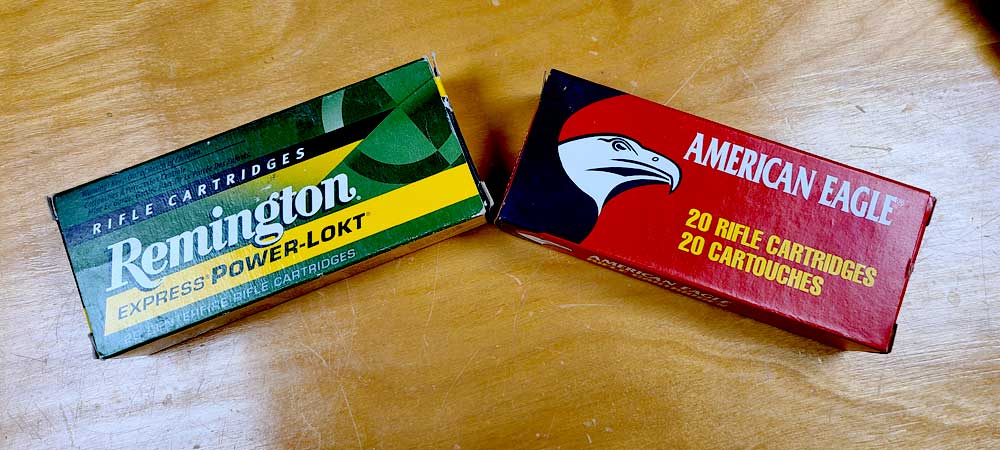
The 223 Remington was developed as a military round. According to most sources, the development goes back to the 1950s, but the 223 Remington was introduced as a commercial round in 1964. The history of it could be an article on its own, but long story short, it is a shortened version of the 222 Remington Magnum. The 5.56 NATO round, which is now the military version, has differences that, though minute, mean it is safe to fire 223 Remington through a 5.56 chambered rifle, but 5.56 ammo should not be fired through a 223 rifle. Some folks will disagree with that statement, and even though in years past I fired them interchangeably, today’s loading manuals all recommend differently. I believe that it is better to err on the side of safety.
The 223 is a fine varmint cartridge and used by lots of folks to deer hunt. The wide variety of bullet weights in factory ammo combined with the variety of factory twist barrels mean that it may take a little effort to find the factory ammo that your rifle prefers. I once owned a Ruger 77 in 223 that would shoot Remington Core-Lokt 55 gr hollow point, as well a Federal’s American 55 grain boat tail ammo into sub-half-inch groups. The same rifle would shoot handloads with Hornady 50 gr V-Max bullets fueled by Hodgdon Varget and Nosler 40 gr Varmageddons pushed by Hodgdon Benchmark well under 0.5-inch groups. I let a friend con me into pricing that rifle, he then laid down the cash! I regret that decision.
While helping Randy Bryant learn the reloading game, we found that his AR would shoot 65 gr Sierra Game Kings using Winchester 748 Powder under 0.5 inch. The same bullet with H335 powder shot a 0.264-inch group. H322 produced a 0.273 group and VihtaVuori N 135 shot 0.502. Four loads in the 0.5-inch range used the same bullet. Randy’s Savage Axis produced groups under 0.5 inch using Nosler’s 65 gr Varmageddon bullet and Hodgdon H335 as well as Hodgdon’s Benchmark. The 223 is a great round to load for. The variety of bullets and powders that result in outstanding accuracy make it fun to work with and relatively easy on your billfold compared to the bigger cartridges.
5. 222 Remington Magnum:
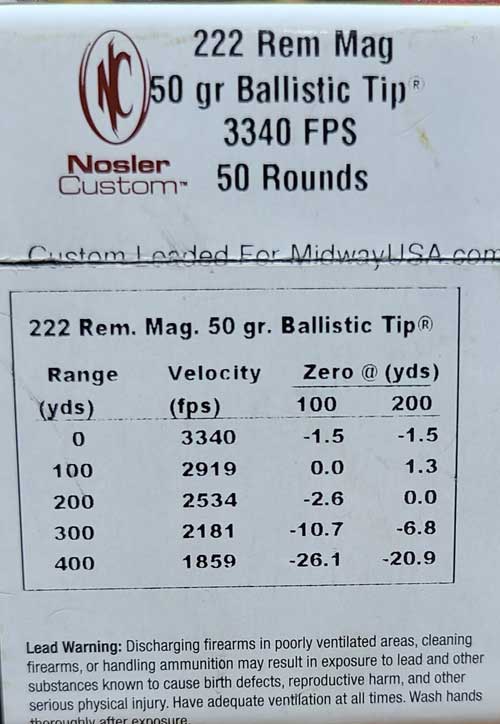
The 222 Remington Magnum, commercialized in 1958, started out as an experimental round for the military. It is 0.15 longer that its parent case the 222 Remington and 0.09 longer than its offspring, the 223 Remington that the military adopted. With a longer case than the 223, it can slightly outperform the 223. The difference is small and the availability of 223 ammo quickly sounded the death knell of the 222 Remington Magnum. No manufacturer has produced a rifle in 222 Remington Magnum for several years, and only Nosler produces factory ammunition at this time. It is relatively expensive and hard to find. Nosler also produces new high-quality brass, which, along with a wide selection of 224 caliber bullets to work with, can give those old rifles out there a new lease on life.
The 222 Remington as well as the magnum version both have reputation for accuracy. I don’t have firsthand knowledge of the 222, but I do with the magnum version. The 222 Magnum never became as popular as its parent case or its offspring (222 Remington, 223 Remington, and 204 Ruger), but this article is about Varmint Cartridges that I love and this one is a jewel!
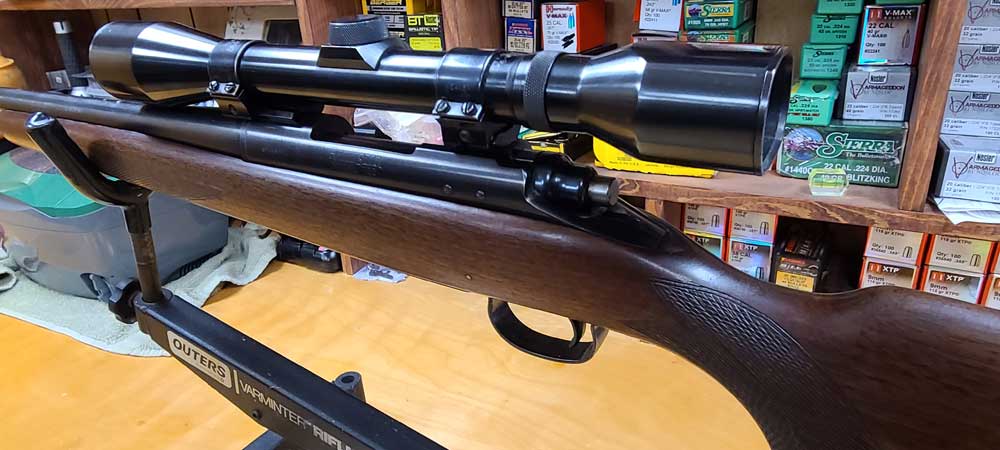
After years of trying to trade a friend out of his Remington 700, I stumbled across an old Remington 722 in 222 Remington magnum. It followed me home! The little 722 had been a little neglected and had an old Weaver K6-W scope mounted. My initial plan was to put a modern scope on the rifle and have the rifle refinished. Several hours of cleaning later, I decided against refinishing the 722 and the old scope matched the rifle so well that I didn’t change it. Since this rig was not intended to be my primary varmint rig, and I loved the way it looked, I decided to see how well I could get it to shoot just like it was. I obtained a set of RCBS dies and went to work. The second trip to the range we had groups under an inch. Three trips later it was consistently putting three shots under 0.5 inch. With a small amount of fine tuning the 60-year-old rifle with the “Vintage” scope is turning in groups less than 0.25 using Sierra 40 gr Blitzking bullets with both Hodgdon Varget and VihtaVuori N133 Powder. You must love an old rig like this - almost no recoil, extremely accurate and it is not hard on the powder supply!
6. 22-250 Remington:
The “Mac-Daddy” of varmint cartridges is probably the 22-250 Remington. There are faster 22 caliber Varmint rounds, but none have achieved the popularity of the 22-250 Remington. It is basically the 250-3000 case necked down to accept 224 diameter bullets. It began as a wildcat round called the 22 Varminter. Browning produced the first commercial rifles in early 1965 simply stamped 22-250. According to most sources, very soon after that, Remington started producing rifles marked 22-250 Remington and manufacturing ammunition head stamped 22-250 Remington.
The 22-250 has accounted for plenty of whitetail deer over the years, but it is primarily a varmint cartridge and an exceptionally good one. Factory ammunition is available in bullet weights ranging from 35 to 64 grains. My old Remington 700 BDL Varmint model will shoot Winchester 52 Grain silvertips into groups well under 0.5 inch. Most factory ammo that I have tried will print under 1-inch groups in bone stock rifles. Handloading opens a whole new world for the 22-250 shooter in terms of speed as well as accuracy. Hornady’s 10th Edition manual lists bullets and loads ranging from 35 gr bullets reaching speeds of 4400 fps to 80 gr match bullets at 3200 fps. Nosler 9th edition lists from 34 gr bullets at 4545 fps to 80 gr at nearly 3200 fps. Sierra Volume VI lists 40 gr pills at 4200 and 90 gr match bullets at 3000 fps.
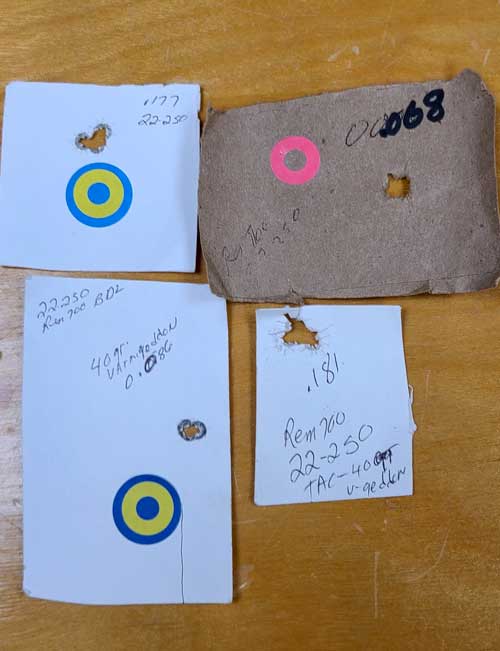
The 22-250 is known for accuracy and my old logbook backs that up. Over the years I have obtained groups under 0.5 inch with just about every 22-250 that I have worked with. I have loaded for Remington 700 BDL Varmint models, 700 SPS, 700 ADL’s, Ruger 77, Mossberg Patriot, Browning Model 78 and Savage 110 as well as custom builds using 40 gr Nosler Varmageddons, Hornady 50 gr V-Max, Sierra 45 gr Spitzers, and Sierra 65 gr Match Kings. A quick count of the logbook revealed 44 different loads that turned in groups under 0.5 inch, and 9 of those were under 0.25 inch. My best group came with Nosler’s 40 gr Varmageddon bullets, TAC powder (now owned by Hodgdon) using a Federal F210 primer, the old BDL shot a 0.068 group at 100 yards. Close behind this group the same load, except with a CCI 200 primer, produced a 0.086-inch group. This 30-year-old rifle has won more than one local match with different shooters. In my experience, the 22-250 Remington lives up to its reputation. Recoil is enough that you momentarily will lose sight of the target, and frequent cleaning and allowing the barrel to properly cool between groups will extend barrel life.
7. 220 Swift:
I wasn’t going to mention the Swift because of my limited experience with it, but its stellar performance during that short period of time caused me to change my mind. Using Hornady and Nosler’s data, you gain anywhere from 13 to 200 fps over the 22-250 Remington. Based on the old 6mm Lee Navy cartridge the 220 Swift is just that “Swift.” Valid or not, the Swift developed a reputation as a barrel burner which nearly killed the round off. In recent years, a few manufacturers have started once again producing the Swift and it is experiencing a slight resurgence in popularity.
Cody Little, knowing that I like a challenge, strolled into my loading room one rainy day carrying a Remington 700 chambered in 220 Swift along with a set of Redding Dies and wanted to see what we could come up with. We loaded four sets of loads, three rounds each, caught a break in the rain and hit the range. Twelve shots later we had a winner. Sierra’s 45 gr spitzer pushed by 40.2 gr VihtaVuori delivered a group of 0.135 inch. Cody decided that that was good enough for coyote hunting. My load development days with “Ol Swifty” were over. The 220 Swift, like the 22-250 needs frequent cooling breaks, and a proper cleaning procedure to prolong barrel life.
Not for me:
I have been told that you shouldn’t hate anything, but darn it, the 223 WSSM brings out the worst in me. At the height of the Short Magnum craze, Winchester came out with the Winchester Super Short Magnum line. The 223 WSSM was the fastest .224 caliber to come down the pike, With Hornady’s 8th edition listing speeds of 4600 fps with a 40-gr bullet. The 223 WSSM was the first rifle that I met that wouldn’t respond to “The Reloaders Touch.”
A good friend, Dustin Cooper, who refers to me a “Uncle Bill,” brought a beautiful Model 70 with a quality scope mounted along with a couple of boxes of factory ammo and a set of dies. He said, “It just wouldn’t group.” He asked me if I would try it. I went through all the usual steps, a thorough cleaning, checked bases and rings to make sure everything was tight. I went to the range and proceeded to shoot 2 to 3-inch groups. A little thing like factory ammo not being too accurate wasn’t that unusual since he only had two kinds of ammo. Fifteen sets of loads later, along with constant cleaning, my best group was 1.3 inches.
The next test loads, using the same recipe, went to 1.6 and then quickly over 2 inches. Nothing I tried seemed to work. I reached out to Mike Gross, owner of Gross Precision, Custom Rifle Builder and National Aggregate Champion shooter in the Outlaw Heavy Class of the ABRA, to see what I was doing wrong. Mike just laughed at me. He said that when he read all the hype about the WSSM series he went out and bought one. While still in load development, the rifle was shooting so bad that he moved his target to 50 yards instead of 100. He discovered that within 200 rounds, his bullets were keyholing. He and Dustin did the same thing with their rifles - sold them! I have read in several online forums of fellows who claim stellar accuracy from their 223 WSSM rifles, but while my experience is limited with this round, I can say, “I DON’T LIKE IT!”
There are plenty of great varmint rounds that I have not tried, but I hope to have the opportunity. The 222 Remington, 224 Valkyrie, 221 Remington Fireball, 22 Hornet, and 22 Nosler to name a few. I have personally fired and loaded for each of the cartridges discussed in this article and taken varmints with most of them. The 204 rides with me in the truck most days on the farm, and I love loading and shooting for the other six. However, when it comes to the 223 WSSM, no thanks!

